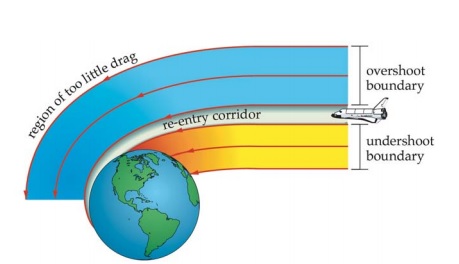How to land on MARS, and walk away from it - Atmospheric Reentry Dynamics
This is a series of easy to understand space mechanics articles and my personal take on trying to educate new people into what space is and the mysteries of science in general. Working for 11 years in the Aviation Industry while also being a science and space geek makes me want to embark in this inspirational trip in science with you and perhaps make you love science a tad more.

SpaceX Making Life Interplanetary Presentation available here (CC0 license as most or everything else availble on SpaceX).
After a successful launch and a successful insertion orbit, it's time for our imaginary craft to try to land. But what are the mechanics of such an attempt? How does a landing on Mars differs from one on Earth or on the Moon? I left this article for last because it's by far the most complex and hard to do event in the whole imaginary trip.
Reentry
The atmosphere on Mars is not as dense as Earth's but it is sufficiently thick and dense to provide a helping hand in stopping a spacecraft or at least slow it down. But how it's done depends a lot on the mission and type or spacecraft you want to land.
If the spacecraft is heavy then it will have more time to stop. If the landing zone is a very specific point on the surface then using parachutes or drag chutes might not be advised. If the spaceship is light but wide it might get away with coming in at a steeper angle.
Let's get to the physics involved, it is easy to understand:
I am using this calculator for calculus, very easy tool.
The formula for the circular orbital velocity is:
Where:
G - Gravitational Constant ( which is 6.67408 × 10-11 m3 kg-1 s-2)
M - Mass of Mars ( 6.4171×1023)
R - Distance from the center of Mars to the orbit ( found by measuring the distance from the spacecraft to the planet and then adding the planet's radius)
By adding the data in the ecuation we have:

So to safely land we need to shake all of that speed in a short amount of time ( the time of descent - which is essentially a freefall). The first operation is to position the spacecraft's thrust in a retrograde position ( terminology is explained here) . Then we only need to burn a little amount of fuel, usually at the Apoapsis, to bring the opposite orbital point of Periapsis to under the altitude where the atmosphere starts. This will slow it down a little and the lower it falls the higher the drag. This means that without further consumption the spacecraft slows down to more manageable speeds while it descends close to the surface.
Now for a little more in-depth explanation of it. You can skip to the next text divider if you have trouble understanding it or you want it extra simple.
We have to balance the following:
- Heating
- Deceleration
- Landing accuracy
In order to safely lose the speed without burning fuel we have to rely on the atmosphere to slow us down by drag. Here we have
E = KE + PE
where
E = total mechanical energy
PE = potential energy
KE = kinetic energy
If we take the Space Shuttle total mechanical energy which is:
E = 3.23 × 1012 joules = 3.06 × 109Btu we realize that it's equivelent to 255000 EU-certified air conditioned units set on maximum setting. A lot of heat. Or as FAA puts it on their official website: "..the Shuttle has enough energy during re-entry to heat the average home in Colorado for 41 years!"
A joule is equal to the energy transferred to an object when a force of one newton acts on that object in the direction of its motion through a distance of one meter (1 Nm).
Btu or British thermal unit, is a traditional unit of heat defined as the amount of heat required to raise the temperature of one pound of water by one degree Fahrenheit.
Our spacecraft needs to trade energy for heat. The more heat it can take and even dissipate into space the faster it can stop. Temperatures of 1500 degrees Celsius (3000 F) are common.
Deceleration is the second main variable to take into account. The human body can only withstand up to 10-12 times its own weight for a short time ( this is called g's). The outside metal structure can take hundreds time more loads. If a spacecraft is manned or not is yet another factor is deciding the trade-offs.
Landing accuracy is the last factor in deciding the landing's type and angle. Some missions have a very specific landing area, such as an existing base and some might have more relaxed specifications, like the Apollo's reentries which concluded in splashdowns in the ocean, allowing for a shallower angle.
The drag force of an object is directly proportional to:
- size (cross-sectional area in the airflow)
- drag coefficient
- velocity
- air density
The drag force formula is:

Fdrag - drag force on a spacecraft in Newtons
CD - drag coefficient
A - spacecraft's cross section area ( in square meters)
ρ - ( greek-rho, in kg per cube meter)
V - spacecraft's velocity (meters per second)
By using Newton's Second Law previously shown to you here, we can calculate its deceleration.
- A - the appropriate glide path of a spacecraft for a successful landing
- B - aircraft-like flight to destination
- C - An Expulsion event, in which the spacecraft is thrown out back in space, caused by a small angle of reentry
- D - The planet's normal vector
- E - High angle over 6.9 degrees causes excess heat on the spacecraft
- F - Low angle under 5.5 degrees that causes the Expulsion event
- G - Rapid Spacecraft Disassembly :) (Explosion caused by excess heat from friction)
- H - The planet's tangential vector
There are many things to add here, there is another formula used by the space engineers to calculate the trajectories but in keeping this article simple enough, I will just define it as the "Ballistic Coefficient" with the formula

BC = spacecraft's ballistic coefficient
m = spacecraft's mass
CD = spacecraft's drag coefficient
A = spacecraft's cross-section area
Landing on Mars
After successful bleeding of the velocity to more manageable levels using the aforementioned techiques, which take the spacecraft all the way into the thicker parts of the atmosphere there are two ways in which to safely land, a powered approach and by using the parachutes.
Using the parachutes is easier but controlling the descent is harder. Weather uncertainties or shape irregularities of the spacecraft might not allow for a small landing zone. The initial deployment of the parachutes might also have structural downsides as the forces applied at parachute deployment are rather big.
A parachute system on a spacecraft involves drogue chutes, pilot chutes, canopies to protect them, detachment charges for cutting the drogues plus all the needed backup systems and testing. Plus you can use it on Mars, but when returning, a spacecraft would need to either refit them, repack the chutes or simply have chutes for Mars and chutes for Earth. This makes it hardly a cheaper or lighter system comparing to the powered approach system.
The powered approach consists of a series of careful fuel burns to maintain the spacecraft on the pre-planned landing vector. Because Mars is smaller than the Earth, these burns are less powerful and less fuel is spent. Upon reaching the landing position, a final burn called a "landing burn" is being made to stop the vehicle in the last possible moment as to reduce the further interaction of the physics after the burn and thus, conserve fuel.
A good example of this type of powered approach is NASA's Mars Exploration Rover:
I saved these for last because I wanted you to also get to know the physics behind it before seeing the movies, so that you can better understand the processes. And also as an eye candy, because let's be real, who doesn't love a good rocket movie.
Another graphical example is the upcoming SpaceX's BFR in 2022 and 2024. Probably the tests will be made even earlier, using the atmosphere of the Earth for reentry. Found a nice 3D rendering from Hazegrayart on Youtube ( which I strongly recommend you to visit):
If you are more into the physics part of the SpaceX landing you can check out their official simulation of the landing:
I conclude the article here, but I am thinking of starting a new series about Mars Colonization using the science we have or will soon have. What can we use there, how would that colonization effort take place, is it even possible. Could we protect ourselves from the elements there and could we even find means to be independent from Earth? I honestly don't know at this moment, but I am willing to research it with you and gather the data. This is still in its infancy but a lot of resources and time is spent by big companies and states to find out more.
I hope I have made you like science and space a little more or at least made you curious.
The other articles in the series:
We have launched a rocket to MARS! Will it get there and how do we stop it once it's there?
How do rockets really get to where they're headed?
Falcon Heavy Launch
Sources:
My passion for science; further formulas and definitions were checked using FAA space documentation, a collection of everything you need regarding formulas and definitions, practically the years of NASA and FAA experiments, found here. All other sources and images specified inline.






Being A SteemStem Member
It was good to see ole Rover again. Mars would be easier if the weather was more consistent
The dust and electrical storms are the worst. Also a storm can take months to clear because of the gravity and the dryness of its atmosphere which keeps the fine dust particles airborne.
Excellent review. i didnt watch all the videos though, just the one on simulated landing.
the quest for humans becoming a multiplanetary specie is still on. i'll be looking forward to your researches on this area. all the best buddy
@alexdory this post is 💯% self explanatory from the calculation using Newton law to every principle behind the landing and taking off of the spaceship.Now I know some of the calculation the NASA guys calculate before sending off spaceship.
You are welcome! I feel that my post is not the best there is, and I am sure that someone else might do a better job. I had to find the balance between easy to read and the science involved :D
Wow, this was a great post. I thought I did pretty well to get through physics in college, but most of this is so far over my head! I love space though and I hope to one day see us move beyond our small area here. I do have a question... Is slow degrading orbit possible to help decelerate the entry vehicle as opposed to just coming straight down? What are the benefits and drawbacks or is my understanding wrong and it just isn't physcially possible?
I am an idiot. I just reviewed your post again and you actually explained it very well. I just didn't comprehend it the first time through. I answered my own question(or rather you did). I apologize :) Great post!
There is nothing wrong in questioning things. This is exactly what I am trying to start here, a healthy debate and engagement in the subject, and I will continue doing it until my inspiration is gone. And I'm pretty sure that will never happen :D
Awesome thanks. I just need to slow down when I read through stuff. I loved your post btw. I look forward to reading more from you.
Good job @Alexdory, you explained it very well. It was a pleasant read and reminder of the mathematics.
It makes me happy to write this kind of articles. I am sure the engagement will grow in time. Maybe we can eventually create something more out of this. Steemit Scholarships for the newbies sounds like a nice idea! :)
I like the sound of that idea. People could make small courses in their specialist field and readers get a steemit recognition.
NICE SIR
SELECT ME SIR
Very interesting things about space and I can't wait the series about Mars Colonization. Have a great weekend!
Thanks a lot! I will have to split my efforts between work, community and science but I will try to keep it together :)
Hi, I found some acronyms/abbreviations in this post. This is how they expand:
Again, you're making rocket science accessible to laymen and making it easy to understand. This time I know a bit more but still find something difficult to understand. After all, this by far is one of the most inspiring series on stemmit. Laymen hardly read and understand something like this.
Thanks a lot. Let's hope they inspire someone.